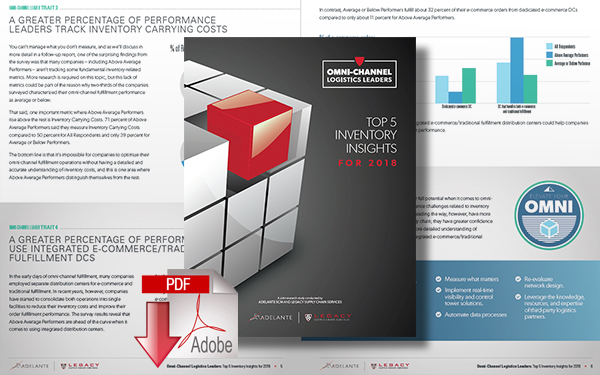How to Manage Warehouse Inventory and Drive Efficiency Across the Supply Chain

Proper warehouse inventory management can be challenging but, if you follow useful advice, you can increase efficiency and reduce costs across your omni-channel supply chain.
A Simple Guide on How to Manage Warehouse Inventory
Omni-channel logistical success is predicated on a number of factors, one of the most important being warehouse inventory management.
Inventory management in warehouses requires more than just organizing products (though that certainly helps): It requires the right alignment of network strategy, facility and process engineering, and technology systems that create inventory visibility and accuracy.
The result is a heightened ability to deliver to your customer via their preferred sales channel, with a cost-to-serve that serves your bottom line.
Proper warehouse inventory management can be challenging but, if you follow this useful advice, you can increase efficiency and reduce costs.
Reevaluate your Warehouse Design
The layout of your warehouse should facilitate logical inventory flow, from receiving and inspection through to picking and packing, to ensure that operations move quickly and smoothly.
A cramped, congested layout makes it difficult for inventory management personnel to access stock and leaves insufficient room for important processes such as receiving, which increases the risk of human error.
It’s especially important to reevaluate your warehouse layout to accommodate increases in company sales, which contribute to increased space requirements.
When revising your warehouse design, ask yourself the following:
- Does my current layout utilize space efficiently?
- Do my employees have enough room to do their jobs properly?
- How long has it been since I last updated my layout? Have we experienced a significant increase in sales volume in that time?
- Do I want to incorporate any specific inventory logistics strategies into my layout (e.g. cross-docking, wave picking, etc.)?
Reorganize your Stock Keeping Units (SKUs)
To ensure efficient operations and inventory management in your warehouse, organize products so that they’re easily accessible to inventory management personnel.
This principle applies not only to your warehouse’s general layout but to your SKUs, as well. Strategically sort your SKUs and use slotting to group items together based on size, velocity, seasonality and other characteristics to reduce the amount of time employees spend searching for specific items.
You might also consider creating zones based on pick type to simplify order picking and reslotting. Place high volume, fast moving SKUs close to shipping areas in easy-to-reach locations so employees can retrieve them quickly.
Finally, adopt lean inventory practices. By identifying and eliminating poor performing products, you can drastically reduce inventory levels and better enable employee efficiency during order fulfillment.
Invest in Technology
A warehouse management system (WMS) is a good place to start. A WMS is software designed to support and optimize warehouse functionality.
A WMS can integrate systems and workflows, strategically organize execution systems, increase inventory visibility, mitigate the risk of demand volatility and more to ensure peak inventory management warehouse performance.
It’s also wise to invest in systems with business intelligence (BI) capabilities. BI uses technology to collect, analyze and transform data into actionable information.
You can use this information to forecast inventory demand based on product and vendor performance, reduce excess inventory, put together fill rate reports, implement real-time inventory tracking and get an accurate account of what’s in stock at any given point in time.
Industry Study looks at Inventory Management as a Critical Function within Omni-Channel Logistics
Omni-Channel Logistics Leaders: Top 5 Inventory Insights
Based on data collected from nearly 100 companies actively engaged in retail, manufacturing and logistics services, this research paper has provided several valuable insights ranging from current challenges & best practices, characteristics of companies considered high performers, and opportunities for improvement from companies lower on the omni-channel performance curve. Download Now!
Automate Everything
One of the benefits of investing in technology is gaining the ability to automate essential workflows, including data collection, barcoding, scanning, picking and packing, shipping, inventory tracking and more.
Automated inventory warehouse management allows for greater scalability, decreases the risk of human error, increases efficiency and saves time and money on manual labor.
Once you’ve implemented inventory management warehouse technology, take care to regularly reevaluate your automation strategy to ensure that it continues to meet your business’s efficiency standards.
Enable your Employees
One of the best ways to improve overall inventory warehouse management is to make it easier for warehouse employees to do their jobs - and to do them efficiently.
This can be as simple as setting strict safety standards to protect your employees from potential harm on the warehouse floor or adjusting your cleaning schedule to a more optimal time. Develop a detailed organization plan so that it’s easier for staff to identify where high-volume products are located.
From a technical perspective, use automation to maintain accurate records of all warehouse activities that employees can refer to on a moment’s notice. Whenever you implement new technology, take the time to host mandatory training sessions and familiarize all warehouse personnel with new software and systems.
By empowering your staff with this valuable knowledge, you present them with additional opportunities to optimize inventory management on an everyday basis
Omni-Channel Success Across the Supply Chain
It goes without saying that an organized warehouse is an efficient warehouse. But even more than that, an organized warehouse plays an important role in driving omni-channel success across the supply chain.
By implementing the practices listed above, as well as investing in the right software systems, you can simplify day-to-day operations, improve employee morale and move inventory faster.
Source: Legacy Supply Chain Services
Related Article: Increase Inventory Visibility across Your Supply Chain and Optimize Omni-Channel Fulfillment
Related Resources
Keeping Up with the Retail Consumer
6 supply chain disciplines retailers must master - developed by Adrian Gonzalez, founder and president of Adelante SCM and LEGACY Supply Chain Services, with a foreword from Rick Blasgen, president and CEO, CSCMP. Download Now!
Evolving a Large U.S. Retailer from Good to Great
LEGACY executed a comprehensive startup project plan to fully transition operational control of LSR Inland Empire operations, discover how this solution was executed with zero disruption to the business. Download Now!
International Transportation: Price Matters, But At What Cost?
This ebook is a comprehensive guide to international transportation, that will help logistics managers better evaluate and plan their; supply chain strategy, logistics infrastructure, and risk mitigation strategy. Download Now!
Rapidly Improve the Performance of Your Warehouse
The Rapid Performance Evaluation identifies opportunities and potential improvements in every aspect of warehouse operations; performance, productivity, service, quality, and systems. Download Now!
Creating Superior Customer Experiences through an Optimized Supply Chain
This paper describes in detail the Jagged Peak ACES model and how it can be used as a methodology for measuring each element of the order lifecycle and its impact on customer experience. Download Now!
Why Outsource Your Direct-to-Customer eCommerce Channel?
To better focus on their core competencies, more and more manufacturers recognize that outsourcing is an effective and economical way to manage their direct-to-customer (D2C) eCommerce channel. Download Now!
More LEGACY Supply Chain Services Resources
Article Topics
LEGACY Supply Chain Services News & Resources
Outsourcing eCommerce Fulfillment to a 3PL Rapidly Improve the Performance of Your Warehouse Logistics 20 Warehouse & Distribution Center Best Practices for Your Supply Chain Warehouse Contingency Planning Template 7 Last Mile Logistics Delivery & Ecommerce Trends You Don’t Want to Overlook Increase Inventory Visibility across Your Supply Chain and Optimize Omni-Channel Fulfillment Omni-Channel Logistics Leaders: Top 5 Inventory Insights More LEGACY Supply Chain ServicesLatest in Supply Chain
Ask an Expert: How Shippers Can Prep for Hurricane Season Apple Accused of Multiple Human Rights Violations South Korea Finally Overtakes China in Goods Exported to U.S. UPS Struggles in First Quarter With Steep Earnings Decline How Supply Chains Are Solving Severe Workplace Shortages SAP Unveils New AI-Driven Supply Chain Innovations How Much Extra Will Consumers Pay for Sustainable Packaging? More Supply Chain





















